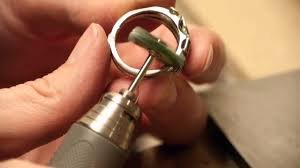Goldsmith: Enameller
SECTOR: GEMS & JEWELLERY
SUB-SECTOR: Handmade gold and gems-set jewellery
OCCUPATION: Gold smithy (Specialised)
REFERENCE ID: G&J/Q0902
ALIGNED TO: NCO-2004/7313.78
Goldsmith-Enameller: Also called ‘Minakari Goldsmith’, the Enameller paints
the finished jewellery for embellishing it as per design. It is a traditional art.
Brief Job Description: The individual at work in handmade gold jewellery
manufacturing prepares enamel colours of different types to paint vibrant
patterns on the finished jewellery frame as per design.
Personal Attributes: The job requires the individual to have: integrity, attention
to details, good eyesight, steady hands, ability to work in a process driven
team, ability to work for long hours in sitting position, a lot of patience, and
creativity. The individual must be able to work in small groups in an enclosed
area, with minimum hazards when dealing with sharp tools and gas torches and
chemicals
Unit Code G&J/N0902
Unit Title
(Task) Paint finished jewellery frame with vibrant enamel colours
Description This OS unit is about minakari or painting patterns with enamel colours on jewellery
frame
Scope This unit/ task covers the following:
Receive work from supervisor
receive the design from supervisor and understand the enamelling
requirement, i.e., colour combinations, type of surface to be prepared, areas
for enamel painting, delivery schedule and methodology to use
order consumables such as enamel lumps, acids and chemicals, brush,
handling tools, safety gear and take stock of equipment such as kiln or furnace
or oven or gas torch
receive the jewellery to be enamelled
Prepare gold jewellery surface for enamel paint application
prepare jeweller surface for adhesion, uniform firing and even colour
distribution
grave or chisel the surface to be painted using chisel or graver for sparkling
finish of large base area or buff the surface for glossy finish or cut motifs,
scoop out or chisel to create motifs or patterns.
prepare enamelling area of even thickness in order to achieve even spread of
enamel while firing
prepare surface of optimum thickness for the enamel to hold an not chip or
crack at a later stage, taking care to protect the surface from being pierced or
punctured
apply enamel to a hollow surface after removing all moisture to avoid enamelsplitting at the time of firing because of moisture tapped in the hollow or
depressed area
remove from the surface any grease, oil grime and dust
clean or degrease using solvents or acid or cleaning solutions after preparing
the surface while avoiding any hand contact with the chemical used
Prepare the enamel
crush the required quantities and colours of enamel lumps and grind with
mortar into fine powder using mortar and pestel (joy & ewly) and add
demineralised (DM) water to the lumps to avoid small particles, ground
enamel and debris from being dispersed in air
protect eyes and skin from injuries from dispersing debris which may contain
glass and other sharp dust particles; Use protective eyewear
repeatedly rinse fine powder and grind, adding Nitric acid to water in order to
remove impurities
take extreme care while rinsing the ground enamel using Nitric acid drops to
avoid skin burns or adverse acid reaction
transfer finely ground paste to a small dish or container with water at a level
slightly higher than the paste
check the paste solution for any impurities and water for any floating particles
add a few drops of vegetable glue as bonding agent for the paste
Apply enamel paint on gold jewellery surface
paint and apply colour on prepared surface using brushes with soft bristles
use jigs to hold the jewellery piece securely while painting
do not spill over paint during application on different sides of the jewel
apply separate colours in separate strokes, i.e., one after another and not all
together
ensure use of separate brushes and containers for different colours
leave the painted surface for a few minutes to dry
take care not to drop the jewellery piece after painting
Fire, retouch and finish
place the painted jewellery piece in the kiln or oven or furnace using stainless
steel mesh for firing or use gas torch at recommended temperature for the
namel
remove the jewellery from the kiln or oven or furnace or gas torch as soon as
the colour melts and flows
leave it to cool to room temperature
check the jewel for excess enamel and remove using Hydrofluoric acid
take extreme precaution while sing Hydrofluoric acid against inhalation, skin
burns or skin contact;
always keep soda-ash-water solution ready in the work area, to be used upon
contact with Hydrofluoric acid
re-fire the jewel for finish as per design, repeat if necessary
remove jewel from kiln, oven, furnace or gas torch and leave to cool
finish the surface with grinder and cutter to remove uneven enamel and gold
rinse with Hydrofluoric acid for uniform spread of enamel applied
re-fire for glossy finish
dry after every rinsing cycle and cool after each firing
use resin colours for non-traditional, i.e., non-Jaipuri or non-Bikaneri, style of
enamelling
Detect product defects
inform supervisor if product has arrived with polishing, cleaning, filing or
linking defect from previous processes
understand the type of defect and send to relevant goldsmith
report impractical design
Check quality and return
use needle to check for chipped or cracked enamel after final firing
in case it is chipped or cracked, leave the jewel in Hydrofluoric acid for 24-72
hour in order to remove the enamel completely and repeat the process
check weight and dimensions of jewellery as per design
Element Performance Criteria Enamelling To be competent, the user/individual on the job must be able to: PC1. achieve smooth finish of enamel paint as per design PC2. ensure no overflow or excess enamel at the edges of the painted area PC3. ensure that enamel prepared with no impurities PC4. ensure no chipping or cracking enamel PC5. prepare surface of thickness and evenness for long term enamel adhesion PC6. fire at right temperature for the enamel PC7. achieve colour, vibrancy and gloss as per design PC8. achieve hazard-free output after using acids and chemicals Controlling gold loss To be competent, the user/individual on the job must be able to: PC9. maintain loss as per company’s loss margin policy PC10. Document account on job sheet as per company policy Productivity To be competent, the user/individual on the job must be able to: PC11. deliver of jewellery in time as committed to client PC12. deliver number of frames painted as per target Quality of output To be competent, the user/individual on the job must be able to: PC13. achieve defect-free and evenly coloured enamelling as per design PC14. deliver maximum number of QC-okayed enamelled pieces Handling problems To be competent, the user/individual on the job must be able to: PC15. deliver complete jewellery on time by reporting problems faced or anticipated well in advance Knowledge and Understanding (K) A. Organizational Context (Knowledge of the company / organization and its processes) The individual on the job needs to know and understand: KA1. company’s policies on: acceptable limits of gold loss per product type, incentives, delivery standards, safety and hazards, integrity and IPR, and personnel management KA2. work flow involved in jewellery manufacturing process of the company KA3. importance of the individual’s role in the workflow KA4. reporting structure KA5. typical customer profile and market trends B. Technical Knowledge The individual on the job needs to know and understand: KB1. jewellery making process and types of jewellery (product, styles, regional, traditional, making technique) KB2. types of enamel, such as transparent, opaque and opal or translucent and their properties: Transparent and opaque easier to apply than opal KB3. hard (firing at 750°C), medium (600-750°C) and soft (<650°C)enamels G&J/N0902 Paint with enamel colours on jewellery frame 7 KB4. enamel available in lumps (longer shelf life), powder and paste forms KB5. choice of mortar and Prestel for grinding powder such as hardened steel, agate, stone that do not leave residue while grinding KB6. expansion and shrinkage rates of gold alloy used and that of the enamels used KB7. adverse effect of very thin base surface, poorly prepared surface or moisture on enamelling outcome KB8. adverse effect of dust and impurities in enamel or on base surface on the outcome KB9. recommended temperatures for different categories of enamel KB10. use of highly hazardous acids and chemicals such as Nitric acid or Hydrofluoric acids and safeguards KB11. filing and soldering Skills (S) [Optional] A. Core Skills/ Generic Skills Basic reading and writing skills The individual on the job needs to know and understand how: SA1. to read notes and put notes on design SA2. to read company policy documents SA3. to read about enamelling and jewellery making techniques Calculation and Geometry skills The individual on the job needs to know and understand how: SA4. to assess gold loss at each step of jewellery making so as to deliver product of correct weight and size SA5. to translate design into enamel painted jewellery Teamwork and multitasking The individual on the job needs to know and understand how: SA6. to share work load with other setters as per capability and work load SA7. to deliver the enamelled jewellery on time B. Professional Skills Painting The individual on the job needs to know and understand how: SB1. to use creativity while painting layers of different colours of enamel SB2. to enamel keeping in mind the requirements of finish, longevity of colour and utility of the design Using tools and consumables The individual on the job needs to know and understand how: SB3. to use demineralised water for grinding, washing and rinsing enamel SB4. to use vegetable glue such as pomegranate seeds for bonding the enamel paste SB5. to use Nitric acid to rinse ground enamel through drop bottles SB6. to use Hydrofluoric acid to wash and remove excess enamel and achieve smooth finish SB7. to use polypropylene steel containers to handle acids SB8. to use mortar and pestel to break and grind enamel lumps into fine powder and grinding stones G&J/N0902 Paint with enamel colours on jewellery frame 8 SB9. to use porcelain and steel dishes for holding enamel paste during application SB10. to use fine bristled brushes for painting SB11. to use chisels and graves for preparing the base gold surface SB12. to use temperature controlled kilns, ovens or furnaces for firing and steel wire mesh for putting the jewel for firing SB13. to use tongs, holders, spatula, plates, ceramic blocks and asbestos boards SB14. to understand hazards involved with chemicals, furnaces and tools used Reducing precious-metal loss The user/individual on the job needs to know and understand: SB15. how to reduce precious metal loss below the prescribed standards SB16. how to collect broken pieces, account in job sheet and return SB17. how to follow company’s policies on collecting gold dust and fragments SB18. how to suggest improvements in order to reduce precious metal loss limits Reflective thinking The individual on the job needs to know and understand how: SB19. to improve work processes SB20. to reduce gold loss and rework because of chipped or cracked enamel Critical thinking The individual on the job needs to know and understand how: SB21. to spot process disruptions and delays
Unit Code G&J/N9910
Unit Title
(Task) Respect IPR of company as well as competitors
Description This OS unit is about maintaining company’s IPR and avoiding infringement on
copyright of others
Scope This unit/task covers the following:
Protect company’s Intellectual Property Rights (IPR)
prevent leak of new designs to competitors by reporting on time
be aware of any of company’s product or design patents
report IPR violations observed in the market, to supervisor or company heads
Avoid infringement to copyright of other companies
read copyright clause of the material published on the internet and any other
printed material
consult supervisor or senior management when in doubt about using publicly
available information
report any infringement observed in the company
Performance Criteria(PC) w.r.t. the Scope
Element Performance Criteria
Respecting IPR To be competent, the user/individual on the job must be able to:
PC1. spot plagiarism and report
PC2. understand rationale of patents and IPR
PC3. avoid being involved in IPR violations
Knowledge and Understanding (K)
A. Organizational
Context
The individual on the job needs to know and understand:
KA1. company’s policies on IPR, plagiarism and order leaks
KA2. company’s patented products
KA3. market trends and company’s unique product range
KA4. reporting structure
B. Technical
Knowledge
The individual on the job needs to know and understand:
KB1. basics of patents and IPR laws
KB2. how IPR protection is important for competitiveness of a company
Skills (S) [Optional]
A. Core Skills/
Generic Skills
Communication skills
The user/individual on the job needs to know and understand how:
SA1. to effectively communicate any observed IPR violations or design leaks
B. Professional Skills Decision making
The user/individual on the job needs to know and understand when and how:
SB1. to report sources of IPR violations
Reflective thinking
The user/individual on the job needs to know and understand how:
SB2. to learn from past mistakes and report IPR violations on time
Critical thinking
The user/individual on the job needs to know and understand how:
SB3. to spot signs of violations and alert authorities in time
Unit Code G&J/N9912
Unit Title
(Task) Coordinate with co-workers
Description This OS unit is about communicating with colleagues and seniors in order to maintain
smooth ad hazards free work flow
Scope This unit/task covers the following:
Interact with supervisor to:
receive work instructions and raw materials from reporting supervisor
communicate to reporting supervisor about process flow improvements, product
defects received from previous process, repairs and maintenance of tools and
machinery as required
communicate any potential hazards or expected process disruptions
handover completed work to supervisor
Interact with colleagues within and outside the department to:
work as a team with colleagues and share work as per their or own work load and
skills
work with colleagues of other departments such as frame making or component
making or polishing or setting or stores
communicate an discuss work flow related difficulties in order to find solutions
with mutual agreement
receive feedback from QC and rework in order to complete work on time
Performance Criteria(PC) w.r.t. the Scope
Element Performance Criteria
Interaction with
supervisor
To be competent, the user/individual on the job must be able to:
PC1. understand the work output requirements
PC2. comply with company policy and rule
PC3. deliver quality work on time as required by reporting any anticipated reasons
for delays
Interactions with
colleagues and other
departments
To be competent, the user/individual on the job must be able to:
PC4. put team over individual goals
PC5. conflicts resolution and multi-tasking
Knowledge and Understanding (K)
A. Organizational
Context
(Knowledge of the
company /
organization and
its processes)
The individual on the job needs to know and understand:
KA1. company’s policies on personnel management
KA2. work flow involved in company’s jewellery manufacturing process
KA3. importance of the individual’s role in the workflow
KA4. reporting structure
B. Technical
Knowledge
The individual on the job needs to know and understand:
KB1. how to communication effectively
KB2. how to build team coordination
Skills (S) [Optional]
A. Core Skills/
Generic Skills
Teamwork and some multitasking
The individual on the job needs to know and understand how:
SA1. to share work load as required
SA2. to deliver product to next work process on time
B. Professional Skills Decision making
The individual on the job needs to know and understand:
SB1. how to report potential areas of disruptions to work process
SB2. when to report to supervisor and when to deal with a colleague depending on
the type of concern
Reflective thinking
The individual on the job needs to know and understand:
SB3. how to improve work process
Critical thinking
The individual on the job needs to know and understand:
SB4. how to spot process disruptions and delays
Unit Code G&J/N9914
Unit Title
(Task) Work towards having a safe work environment
Description This OS unit is about being aware of and communicating potential hazards and
dangers of accidents on the job
Scope This unit/task covers the following:
Understand potential sources of accidents
to avoid accidents related to use of potentially dangerous chemicals, gas torches,
sharp tools and hazards from machines
Communicate to reporting supervisor about:
process flow improvements to reduce anticipated or repetitive hazards
mishandling of tools, machines or hazardous materials
electrical problems that could result in accident
Performance Criteria(PC) w.r.t. the Scope
Element Performance Criteria
Understanding of
potential sources of
accidents and
communicating
To be competent, the user/individual on the job must be able to:
PC1. spot and report potential hazards on time
PC2. follow company policy and rules regarding hazardous materials
PC3. deliver quality work on time as required by reporting any anticipated reasons
for delays
Knowledge and Understanding (K)
A. Organizational
Context
(Knowledge of the
company /
organization and
its processes)
The individual on the job needs to know and understand:
KA1. company’s policies on handling: harmful chemicals and sharp tools, safety and
hazards of machines, fire safety and, disposal of harmful chemicals and
materials
KA2. work flow involved in company’s jewellery manufacturing process
KA3. importance of the individual’s role in the workflow
KA4. reporting structure
B. Technical
Knowledge
The individual on the job needs to know and understand:
KB1. how different chemicals react and what could be the danger from them
KB2. how to use machines and tools without causing bodily harm
KB3. fire safety education
KB4. disposal of hazardous chemicals, tools and materials by following prescribed
environmental norms or as per company policy
Skills (S) [Optional]
A. Core Skills/
Generic Skills
Communication skills
The individual on the job needs to know and understand how:
SA1. to effectively communicate the danger
B. Professional Skills Decision making
The individual on the job needs to know and understand:
SB1. importance of reporting potential sources of danger
SB2. appropriate actions to be taken in the event of an accident
SB3. procedure for disposing of hazardous materials, safely and following
environmental guidelines
Reflective thinking
The individual on the job needs to know and understand how:
SB4. to learn from past mistakes regarding use of hazardous machines or
chemicals or gas torches
Critical thinking
The individual on the job needs to know and understand:
SB5. how to spot danger
SB6. procedure to follow in the event of a fire or other hazard
Keywords /Terms Description
Sector Sector is a conglomeration of different business operations having similar
business and interests. It may also be defined as a distinct subset of the
economy whose components share similar characteristics and interests.
Sub-sector Sub-sector is derived from a further breakdown based on the
characteristics and interests of its components.
Occupation Occupation is a set of job roles, which perform similar/ related set of
functions in an industry.
Function Function is an activity necessary for achieving the key purpose of the
sector, occupation, or an area of work, which can be carried out by a
person or a group of persons. Functions are identified through functional
analysis and form the basis of OS.
Sub-function Sub-functions are sub-activities essential to fulfil the achieving the
objectives of the function.
Job role Job role defines a unique set of functions that together form a unique
employment opportunity in an organisation.
Occupational Standards
(OS)
OS specify the standards of performance an individual must achieve
when carrying out a function in the workplace, together with the
knowledge and understanding they need to meet that standard
consistently. Occupational Standards are applicable both in the Indian
and global contexts.
Performance Criteria Performance criteria are statements that together specify the standard of
performance required when carrying out a task.
National Occupational
Standards (OS)
NOS are occupational standards which apply uniquely in the Indian
context.
Qualifications Pack (QP) QP comprises the set of OS, together with the educational, training and
other criteria required to perform a job role. A QP is assigned a unique
qualifications pack code.
Unit Code Unit code is a unique identifier for an Occupational Standard, which is
denoted by an ‘N’
Unit Title Unit title gives a clear overall statement about what the incumbent
should be able to do.
Description Description gives a short summary of the unit content. This would be
helpful to anyone searching on a database to verify that this is the
appropriate OS they are looking for.
Scope Scope is a set of statements specifying the range of variables that an
individual may have to deal with in carrying out the function which have
a critical impact on quality of performance required.
Knowledge and
Understanding
Knowledge and understanding are statements which together specify the
technical, generic, professional and organisational specific knowledge
that an individual needs in order to perform to the required standard.
Organisational Context Organisational context includes the way the organisation is structured
and how it operates, including the extent of operative knowledge
managers have of their relevant areas of responsibility.
Technical Knowledge Technical knowledge is the specific knowledge needed to accomplish
specific designated responsibilities.
Core Skills/ Generic
Skills
Core skills or generic skills are a group of skills that are the key to learning
and working in today’s world. These skills are typically needed in any
work environment in today’s world. These skills are typically needed in
any work environment. In the context of the OS, these include
communication related skills that are applicable to most job roles.
Keywords /Terms Description
IPR Intellectual Property Rights
NOS National Occupational Standard(s)
NVQF National Vocational Qualifications Framework
NSQF National Qualifications Framework
NVEQF National Vocational Education Qualifications Framework
QP Qualifications Pack
CRITERIA FOR ASSESSMENT OF TRAINEES
Job Role Enameller
Qualification Pack Enameller – G&J/Q0902
Sector Skill Council GEMS & JEWELLERY
To pass the Assessment, a candidate needs to score 50% in Theory and 70% in Practical
Assessment Strategy Marks Allocation
NOS Elements Performance Criteria Theory Practical
1.G&J/N0902 Paint with
enamel colours on jewellery
frame
Enamelling
To be competent, the user/individual on the job must be able to:
PC1. achieve smooth finish of enamel paint as per design 1 6
PC2. ensure no overflow or excess enamel at the edges of the painted area
1 6
PC3. ensure that enamel prepared with no impurities
1 6
PC4. ensure no chipping or cracking enamel
1 6
PC5. prepare surface of thickness and evenness for long term enamel adhesion
1 6
PC6. fire at right temperature for the enamel
1 5
PC7. achieve colour, vibrancy and gloss as per design
1 5
PC8. achieve hazard-free output after using acids and chemicals
1 4
Controlling gold loss
To be competent, the user/individual on the job must be able to:
PC8. maintain loss as per company’s loss margin policy 1 5
PC9. document accounts on job sheet as per company policy
1 3
Productivity
To be competent, the user/individual on the job must be able to:
PC11. deliver of jewellery in time as committed to client 1 2
PC12. deliver number of frames painted as per target 1 4
Quality of output
To be competent, the user/individual on the job must be able to:
PC13. achieve defect-free and evenly coloured enamelling as per design 1 4
PC14. deliver maximum number of QC-okayed enamelled pieces 1 4
Handling problems
To be competent, the user/individual on the job must be able to:
PC15. deliver complete jewellery on time by reporting problems faced or anticipated
well in advance 1 5
Sub Total 15 71
To be competent, the user/individual on the job must be able to:
PC1. Spot plagiarism and report 1
PC2. understand rationale of patents and IPR 1
PC3. avoid being involved in IPR violations 1
Sub Total 1 2
- G&J/ N 9912 Coordinate
with others
Interaction with
supervisor
To be competent, the user/individual on the job must be able to:
PC1. Understand the work output requirements 1
PC2. Understand company policy and rule 1
PC3. Deliver quality work on time as required by reporting any anticipated reasons for delays 2
Interactions with
colleagues and other
departments
To be competent, the user/individual on the job must be able to:
PC4. Put team over individual goals 2
PC5. resolve conflicts and multi-task 2
Sub Total 2 6 - G&J/ N 9914 Maintain safe
work environment
Understanding of
potential sources of
accidents and
communicating
PC1. Spot and report potential hazards on time 1
PC2. Follow company policy and rules regarding use of hazardous materials 1
PC3. Deliver quality work on time as required by reporting any anticipated reasons for delays 1
Sub Total 2 1
Total 20 80
Grand Total 100








